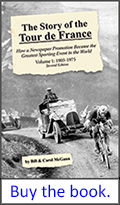Chairman Bill's History of the Tour de France:
the 1920s
How a Newspaper Promotion Became the World's Greatest Sporting Event
Index: origins and early years | 1910s | 1920s | 1930s | 1940s | 1950s | 1960s | 1970s | 1980s | 1990s | 2000s

This excerpt is from "The Story of the Tour de France", Volume 1 If you enjoy it we hope you will consider purchasing the book, either print or electronic. The Amazon link here will make either purchase easy.
1920. Desgrange stuck to the basic formula he had used since 1910: 15 stages over about 5,000 kilometers, going counter-clockwise around the perimeter of France. In 1920, it was 5,519 kilometers to be exact, from Sunday, June 27 to Sunday, July 25. He kept this configuration through 1924. 113 riders started that Sunday in June, 1920.
Philippe Thys had attempted the 1919 Tour in poor physical condition, being unable to finish even the first stage. Humiliated by the verbal caning Desgrange gave him in the pages of L'Auto, Thys resumed his habits of hard work and trained assiduously over the winter. By the start of the 1920 season he was ready to begin racing at his former high level. It almost all came to naught when he broke his collarbone in a crash in Milan-San Remo in March. Made of steel, Thys finished the remaining 50 kilometers of that race. He was able to recover his form in time to start the Tour. He rode for the manufacturer's consortium, La Sportive and had as manager Alphonse Baugé, who had been the architect of many of both Peugeot's and Alcyon's pre-war victories.
 |
||
|
Louis Mottiat wins the first stage. |
||
With his win in the second stage from La Havre to Cherbourg, Thys became first among the 5 who were still tied on time for first place in the General Classification. He was now the Yellow Jersey and never relinquished the lead from then on.
The first 5 stages ended in big sprints. Desgrange hated that. He wanted his riders suffering and straggling in one by one. Henri Pélissier showed his wonderful class by winning 2 of those stages, numbers 3 and 4. He would have been leading the Tour at that point if he hadn't lost almost 17 minutes in the first stage.
Again, Henri Pélissier's stubborn, angry side came out. On stage 5 Henri threw away a spent tire. Desgrange assessed him a 2-minute penalty. Tour rules were strict. A rider must end a stage with everything he had at the start: clothing, tires, etc. Henri did the predictable thing. He quit. Desgrange also did the predictable. He used his newspaper, L'Auto, to make fun of Pélissier. Desgrange said Pélissier didn't know how to suffer and that he would never win the Tour.
 |
||
|
Stage 6, on the Toumalet. This stage would take the winner, Firmin Lambot, over 15 hours to complete. The rider on the left, Jean Rossius would finish over an hour later. The rider on the right, Jules Masselis would need 18 hours, 35 minutes to finish the stage. And he finished in the middle of the field. |
||
 |
|||
|
Eugène Christophe in the Pyrenees, before back pains forced him to quit. |
|||
 |
|||
|
A rough and tumble arrival into Aix en Provence for the end of the 8th stage. Louis Heusghem beat the field by over 8 minutes. |
|||
In that same stage 9 the epic suffering of Honoré Barthélémy started when he had a hard crash. His back was so badly hurt he had to turn his handlebars up so that he didn't have to bend over as far. Yet that wasn't the worst of the crash. A road flint had pierced and ruined one eye. He was not only bleeding and beat up, he was now half blind. Unstoppable, he removed the flint, re-mounted his bike and finished the stage. We're not done with Honoré yet.
The Tour did have imperfections in its organization. The Yellow Jersey hadn't been awarded to the Tour's leader that year so far. After Thys' victory in stage 9, he was belatedly given the Maillot Jaune.
 |
||
|
Stage 10, the pack climbs the Allos. |
||
 |
||
|
The lead riders on the Galibier in the Alps, likely Firmim Lambot and Leon Scieur. |
||
 |
||
|
Philippe Thys after winning stage 13. Just two more days of racing left. |
||
Philippe Thys had done what no other racer had been able to accomplish. By winning the 1920 Tour de France, he was the first to win 3 Tours. This feat would not be matched again until the 1953, '54, and '55 triple victories of Louison Bobet. Thys' completion of the hat-trick came 7 years after his first win. He surely would have won more if the war had not interrupted his career. L'Auto thought that without the Great War's interruption Thys might have been winning his sixth or seventh Tour.
 |
||
|
Philippe Thys. Would he have won 7 Tours if there had been no war? |
||
Thys' 1920 victory continued the domination of the Tour by Belgian riders. Belgians won in 1912, '13, '14, '19, '20, '21, '22, '26, and '29.
Let's look at how the small nation of Belgium mastered the 1920 Tour de France.
- 1. Victory in the General Classification
- 2. Belgians took the top 7 places overall
- 3. Belgians won 12 of the 15 stages
- 4. The Yellow Jersey was always worn by a Belgian, from Mottiat after stage 1 until Thys' final victory in stage 15
1920 Tour de France final General Classification (all rode for the La Sportive manufacturer's consortium):
- 1. Philippe Thys: 228 hours 36 minutes 13 seconds
- 2. Hector Heusghem @ 57 minutes 21 seconds
- 3. Firmin Lambot @ 1 hour 39 minutes 35 seconds
- 4. Léon Scieur @ 1 hour 44 minutes 58 seconds
- 5. Émile Masson, Sr. @ 2 hours 56 minutes 52 seconds
Complete 1920 Tour de France stage details
1921. The Story of the 1921 Tour de France has been moved to the 1921 Tour results page.
1922. The Story of the 1922 Tour de France has been moved to the 1922 Tour results page.
1923. The Story of the 1923 Tour de France has been moved to the 1923 Tour results page.
1924. The Story of the 1924 Tour de France has been moved to the 1924 Tour results page.
1925. The Story of the 1925 Tour de France has been moved to the 1925 Tour results page.
1926. The Story of the 1926 Tour de France has been moved to the 1926 Tour results page.
1927. The Story of the 1927 Tour de France has been moved to the 1927 Tour results page.
1928. The Story of the 1928 Tour de France has been moved to the 1928 Tour results page.
1929. The Story of the 1929 Tour de France has been moved to the 1929 Tour results page.









